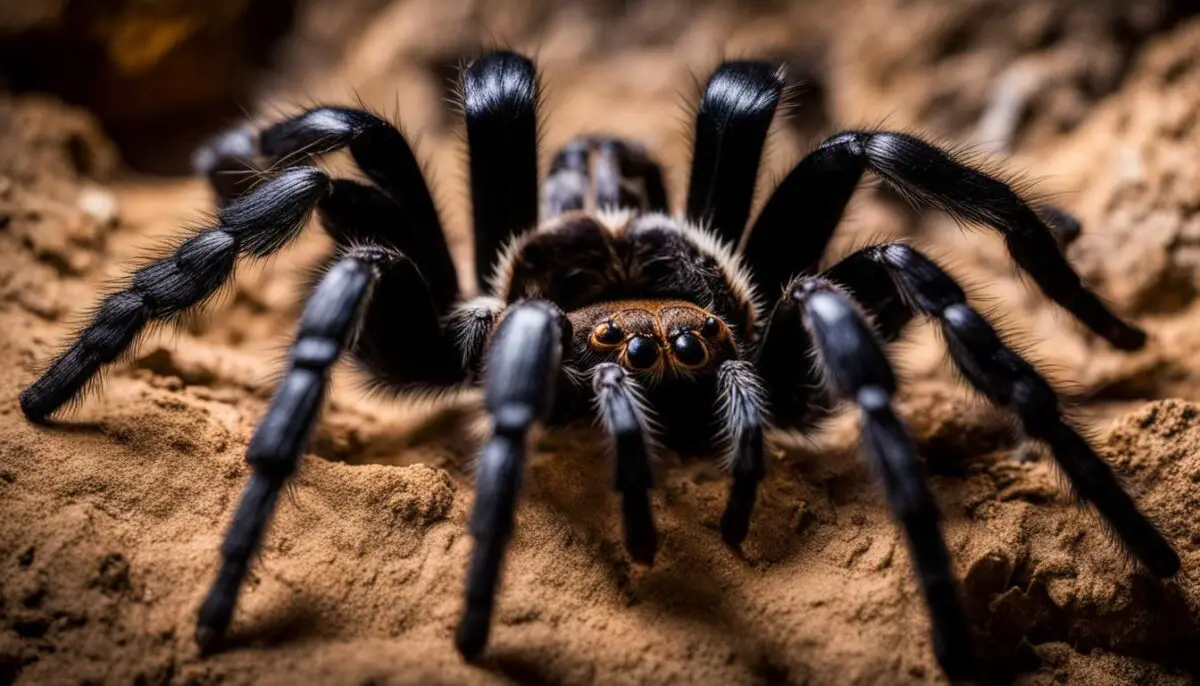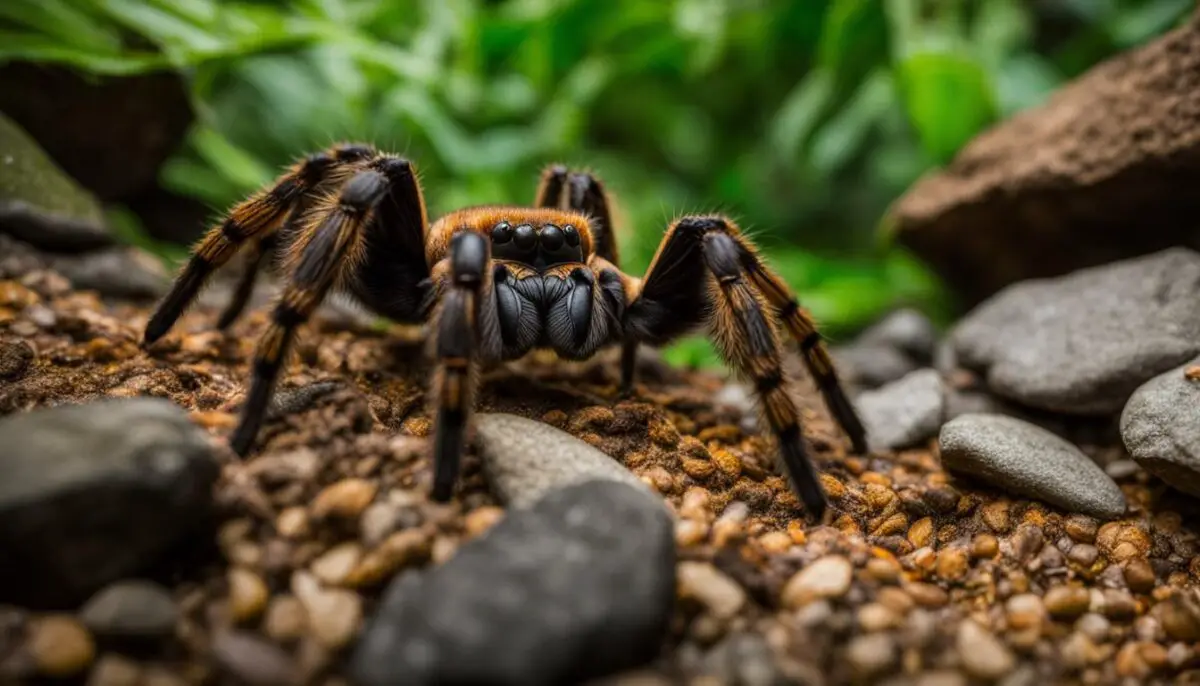If you’ve ever been curious about where tarantulas live and roam around the world, look no further! Our interactive map guide will take you on a virtual journey to explore the distribution of these fascinating creatures.
Tarantulas can be found in various habitats across the globe. With over 800 documented species, these spiders have made their homes in diverse environments. From deserts to forests, tarantulas have adapted to survive in different climates and landscapes.
In the United States alone, you can find around 30 different species of tarantulas. One common species is the Oklahoma brown tarantula, also known as the Texas brown tarantula and Missouri tarantula. They can be found in states like Oklahoma, Texas, Missouri, Kansas, Arkansas, Louisiana, and parts of Mexico. Despite their intimidating appearance, tarantulas are docile creatures and primarily hunt at night.
Explore our interactive map guide to discover more about tarantula habitats worldwide. Learn about their distribution, behaviors, and adaptations that allow them to thrive in their respective environments.
Key Takeaways:
- Tarantulas can be found in various habitats around the world.
- An interactive map guide is available to explore their distribution.
- There are over 800 documented tarantula species globally.
- The Oklahoma brown tarantula is a common species found in the United States.
- Tarantulas do not spin webs but instead burrow into the ground.
Where Tarantulas Live Map
The Oklahoma Brown Tarantula
The Oklahoma brown tarantula, scientifically known as Aphonopelma hentzi, is a species commonly found in Oklahoma and other states in the southern United States. This fascinating arachnid can weigh between 1 to 3 ounces and have a leg span of 4 to 5 inches when fully grown. where tarantulas live map
This particular species of tarantula primarily inhabits arid and desert environments but can also be found in damp forest areas. They seek shelter near rocks and logs where they can burrow, creating a safe and cozy home for themselves.
| Tarantula Species | Location |
|---|---|
| Oklahoma brown tarantula | Oklahoma, Texas, Missouri, Kansas, Arkansas, Louisiana, and parts of Mexico |
The southwestern part of Oklahoma is particularly common for the Oklahoma brown tarantula due to its arid climate, which provides the ideal conditions for their survival. Female tarantulas of this species can live up to three decades, while males typically have a shorter lifespan of less than a year. These remarkable creatures, despite their intimidating appearance, have a docile nature and are not usually aggressive towards humans. tarantula distribution map
Tarantula Species Locations
The Oklahoma brown tarantula, or Aphonopelma hentzi, can be found in the following locations:
- Oklahoma
- Texas
- Missouri
- Kansas
- Arkansas
- Louisiana
- Parts of Mexico
These regions provide the suitable habitats that the Oklahoma brown tarantula requires for survival. With a diverse range of environments, from arid deserts to damp forests, these tarantulas have adapted to various conditions in their range. tarantula species locations
Australian Tarantula Species and Their Habitats
Australia is home to a diverse range of tarantula species, each with its unique characteristics and habitats. Among the notable genera found in Australia are Selenocosmia, Selenotholus, Selenotypus, and Coremiocnemis. These tarantulas vary in size, coloration, and behavior, adding to the rich tapestry of the country’s arachnid fauna.
One example of an Australian tarantula species is Selenotypus plumipes, known for its distinctive long hairs on the rear legs. This species, like many others, constructs web-lined burrows in the ground as the primary dwelling for female tarantulas. The burrows provide protection from predators and serve as a safe space for molting and reproduction. In contrast, younger stages and males prefer to utilize silk retreats under rocks and logs. spider distribution map
The distribution of Australian tarantulas spans across several states, with Queensland, New South Wales, South Australia, and Western Australia being the primary regions where these fascinating creatures can be found. The varying habitats within these states, from arid regions to more humid forests, provide different ecological niches for tarantulas to thrive. These habitats offer ample prey opportunities and suitable conditions for tarantulas to establish their territories.
| Tarantula Species | Habitat | Distribution |
|---|---|---|
| Selenocosmia | Arid and desert environments | Primarily Queensland, New South Wales |
| Selenotholus | Forest areas | Primarily Queensland, New South Wales |
| Selenotypus | Diverse habitats | Primarily Queensland, New South Wales, South Australia |
| Coremiocnemis | Forest areas | Primarily Queensland, Western Australia |
Exploring the various tarantula habitats in Australia provides a fascinating glimpse into the intricate web of life that exists within these regions. By understanding the unique ecological requirements of different tarantula species, we can appreciate their vital role in maintaining the balance of Australia’s diverse ecosystems. where do tarantulas live
Tarantula Conservation Concerns
Conservation efforts are crucial to preserve the habitats and populations of tarantulas, including the unique and diverse species found in Australia. The growing popularity of the pet trade, particularly in northern Queensland, raises concerns about the impact on these spiders. Collecting tarantulas for the pet trade can potentially endanger species that have not been adequately studied or described yet. global tarantula habitats
Some traders recognize this risk and are developing captive breeding programs to mitigate the negative impact on wild populations. By breeding tarantulas in captivity, it reduces the pressure on wild populations and helps ensure the preservation of these fascinating creatures.
“Collecting tarantulas for the pet trade can potentially endanger species that have not been properly studied or described yet.”
To address these conservation concerns, it is important to encourage responsible pet ownership. Prospective tarantula owners should thoroughly research the specific needs and requirements of these spiders before acquiring them as pets. Supporting organizations and initiatives focused on tarantula conservation is another way to contribute to their preservation.
Table: Endangered Tarantula Species
| Tarantula Species | Conservation Status |
|---|---|
| Species A | Endangered |
| Species B | Vulnerable |
| Species C | Critical |
By raising awareness about the conservation concerns for tarantulas and taking steps to protect their habitats, we can ensure the long-term survival of these incredible creatures. Tarantulas play an essential role in maintaining ecological balance and biodiversity, and their preservation is crucial for the overall health of ecosystems they inhabit.
Tarantula Feeding and Behavior
Tarantulas, including the Oklahoma brown tarantula and various Australian species, have unique feeding habits and fascinating behaviors. Understanding their diet, behaviors, and adaptations provides insight into their survival strategies in diverse environments.
Tarantula Diet
Tarantulas are carnivorous creatures that primarily feed on insects, lizards, frogs, and other spiders. Contrary to their name, tarantulas rarely eat birds, as their prey typically consists of smaller creatures found within their habitat. Their diet ensures a balance of essential nutrients for their survival.
While tarantulas capture their prey by injecting venom through their fangs, they do not eat their prey directly. Instead, they use digestive enzymes to break down the captured animal’s tissues, effectively turning it into a liquid form. Tarantulas then suck this liquefied meal into their mouths.
Tarantula Behaviors and Adaptations
Tarantulas have evolved various behaviors and adaptations to thrive in their environments. These adaptations contribute to their survival, predator avoidance, and successful reproduction:
- Hair Pads for Grip: Tarantulas possess thick hair pads on their legs and feet, providing them with exceptional grip for climbing smooth surfaces and capturing prey.
- Molting and Webbing: During the molting process, tarantulas shed their old exoskeleton and construct a cradle of webbing to support themselves. This protective structure helps prevent injury during the vulnerable period.
- Defensive Displays: When threatened, tarantulas may rear up in a defensive posture, displaying their fangs and warning potential predators of their venomous capabilities.
- Aquatic Adaptations: Some tarantula species, particularly those in wetter regions, have adapted to survive in water. They can swim and even coat themselves in air bubbles during the wet season to maintain oxygen levels.
These behaviors and adaptations highlight the remarkable abilities and strategies tarantulas have developed to thrive in their respective ecosystems.
| Tarantula Diet | Tarantula Behaviors | Tarantula Adaptations |
|---|---|---|
| Insects | Hair pads for grip | Molting and webbing |
| Lizards | Defensive displays | Aquatic adaptations |
| Frogs | ||
| Other spiders |
By observing and studying tarantula feeding habits and behaviors, scientists can gain valuable insights into the dynamics of ecosystems and the intricate relationships between species. These remarkable creatures continue to captivate researchers and enthusiasts alike, inviting further exploration and understanding of their unique adaptations.

Tarantula Communication and Life Cycle
Communication and reproduction play significant roles in the life cycle of tarantulas. These fascinating creatures have developed unique ways to communicate with each other and ensure the survival of their species.
Tarantula Communication
Tarantulas are known for their ability to produce sounds as a means of communication. Australian tarantulas, often referred to as whistling or barking spiders, create these distinctive sounds as a defensive display. When threatened, they may generate audible noises by rubbing body parts together, such as their legs or pedipalps. These sounds serve as warnings to potential predators or as a way to communicate territorial boundaries to other tarantulas in the area.
Additionally, tarantulas use chemical signals to communicate with each other. They release pheromones, which are scent-based chemical messages, to convey information about their reproductive status or to attract potential mates. These pheromones are detected by specialized sensory organs called chemoreceptors, located on the limbs and pedipalps of the tarantula.
Tarantula Life Cycle and Reproduction
The life cycle of tarantulas involves multiple molting stages as they grow and develop. After hatching from the egg sac, young tarantulas, known as spiderlings, undergo a series of molts, shedding their exoskeletons to accommodate their increasing size. Each molt represents a new stage of growth and development.
Female tarantulas reach sexual maturity after several years of molting, while males typically mature at a faster rate. Breeding behaviors in tarantulas involve intricate processes to reduce the risk of male mortality. Male tarantulas signal their interest in mating by drumming on the ground or the female’s web, creating vibrations that can be detected by the female. If the female is receptive, the mating process begins, and the male carefully approaches her.
Table: Tarantula Life Cycle
| Stage | Duration | Description |
|---|---|---|
| Egg | Approximately 4-6 weeks | The female tarantula lays eggs and protects the egg sac until the spiderlings hatch. |
| Spiderling | Several months to a few years | The spiderlings molt multiple times as they grow and develop. |
| Subadult | Varies by species | The tarantula continues to molt and increase in size towards sexual maturity. |
| Adult | Varies by species | The tarantula reaches sexual maturity and can reproduce. |
Tarantulas have evolved fascinating adaptations to ensure their survival, from unique communication methods to intricate reproductive behaviors. Understanding these aspects of their life cycle provides further insight into these remarkable creatures.
Tarantula Habitats in Africa
Africa is a diverse continent with a wide range of habitats that provide homes for various tarantula species. From the deserts of Namibia to the rainforests of Madagascar, tarantulas have adapted to survive in different environments. While specific details regarding their habitats and distribution in Africa are not available, it is known that African tarantulas inhabit regions across the continent. tarantula range map
The African tarantulas are a diverse group of spiders that have unique characteristics and behaviors. Although they may differ in size, color, and habitat preferences, they share a common ability to adapt to their surroundings. Some African tarantulas are known for their striking coloration, while others are more elusive and blend into their surroundings. These spiders can be found in various countries across Africa, including South Africa, Tanzania, Kenya, and Cameroon.
One of the challenges of studying African tarantulas is the vastness of the continent and the limited research conducted on these spiders. However, researchers and enthusiasts continue to explore and document the tarantula species found in Africa, contributing to our understanding of their distribution and habitats. Further research is needed to uncover more about the unique tarantula populations in Africa and the specific habitats they call home. tarantula geographical distribution

Tarantula Safety and Interaction with Humans
When it comes to tarantulas, there is often a misconception about their behavior and potential danger to humans. While it is true that tarantulas possess venom and can deliver a painful bite, they are not typically aggressive creatures. In fact, tarantulas are generally docile and prefer to avoid confrontation.
When threatened, tarantulas may rear up in a defensive posture, displaying their fangs and leg spines as a warning. However, they will typically only bite if they feel directly threatened or cornered. It is important to remember that tarantulas would rather retreat than engage in a confrontation with a human.
Given their docile nature, handling tarantulas should only be done by those with the necessary experience and knowledge. It is recommended to seek guidance from experts or attend educational programs before attempting to handle these creatures. Proper handling techniques can minimize stress for the tarantulas and reduce the risk of accidents.
In the event of a tarantula bite, it is advisable to seek medical attention. While tarantula bites are not usually life-threatening, they can cause pain, swelling, and other localized symptoms. Severe illness and systemic reactions, including nausea and vomiting, have been reported in rare cases. Prompt medical evaluation can ensure appropriate treatment and minimize complications.
Table: Tarantula Safety Guidelines
| Do’s | Don’ts |
|---|---|
|
|
By respecting the natural behaviors of tarantulas and following safety guidelines, it is possible to coexist with these fascinating creatures. Tarantulas play an important role in their ecosystems and contribute to the balance of nature. Appreciating their beauty and understanding their behavior can lead to a greater appreciation for these unique arachnids.

Tarantula Safety Policies in Zoos
When visiting a zoo, it’s essential to understand the safety policies in place to ensure a positive experience for both visitors and the tarantulas on display. Tarantulas, with their fascinating appearance and behaviors, can be a highlight of any zoo exhibit. To ensure the safety of both the public and the spiders, zoos have specific guidelines to follow.
Visitor guidelines play a crucial role in tarantula safety. These guidelines typically include instructions to avoid touching or provoking the tarantulas, as they can respond defensively if they feel threatened. It’s important for visitors to maintain a safe distance from the tarantula exhibits and to never attempt to handle or remove the spiders from their enclosures.
Zoos also prioritize the well-being of their tarantulas by designing exhibits that provide a secure and comfortable environment. These exhibits are carefully constructed to mimic the natural habitats of the tarantulas, ensuring they have appropriate hiding spots, temperature, and humidity levels. By recreating these conditions, zoos aim to support the physical and behavioral needs of the tarantulas.
| Tarantula Safety Guidelines in Zoos |
|---|
| 1. Do not touch or handle the tarantulas |
| 2. Maintain a safe distance from the tarantula exhibits |
| 3. Follow the instructions provided by zoo staff |
| 4. Respect the tarantulas’ natural behaviors and habitats |
By adhering to these safety policies and guidelines, visitors can enjoy observing the unique behaviors of tarantulas while ensuring the well-being of these fascinating creatures. Zoos play a vital role in education and conservation, raising awareness about tarantulas and their importance in the ecosystem. They provide an opportunity for people to learn and appreciate these incredible spiders in a safe and controlled environment.

Tarantula Conservation Efforts in Zoos
Tarantulas play a vital role in maintaining the balance of ecosystems around the world. To ensure the preservation of these incredible creatures, many zoos have implemented tarantula conservation programs. These programs focus on protecting tarantula populations, promoting research and education, and raising awareness about the importance of tarantula conservation.
Zoos play a significant role in tarantula conservation by providing a safe and controlled environment for these vulnerable species. Through captive breeding programs, zoos work to increase the population numbers of threatened tarantula species. This not only helps to prevent their extinction but also provides opportunities for scientific study and observation.
Table: Tarantula Conservation Programs in Zoos
| Zoo | Location | Conservation Initiatives |
|---|---|---|
| Zoo A | City A | Establishment of a dedicated tarantula breeding facility Collaboration with local research institutions for conservation studies Education programs on tarantula conservation |
| Zoo B | City B | Participation in field research to study tarantula habitats Creation of tarantula exhibits to raise public awareness Collaboration with international conservation organizations |
| Zoo C | City C | Engagement in tarantula habitat restoration projects Support for local community-based conservation efforts Contribution to global tarantula conservation databases |
These zoos also prioritize education and public engagement to foster a deeper understanding and appreciation for tarantulas. Through interactive exhibits, educational materials, and guided tours, visitors can learn about the importance of tarantulas in ecosystems and the threats they face. By educating the public, zoos aim to inspire individuals to take action and support tarantula conservation efforts.
Furthermore, zoos often collaborate with scientific institutions, conservation organizations, and local communities to develop comprehensive conservation strategies. They contribute valuable data on tarantula populations, habitat conservation, and the impact of human activities on these species. By working together, zoo professionals and conservation experts can make informed decisions and implement effective measures to protect tarantulas.
Tarantula conservation programs in zoos ensure the long-term survival of these remarkable creatures. By preserving their habitats, conducting research, and engaging the public, zoos play a crucial role in the conservation of tarantulas and the ecosystems they inhabit.

Tarantula Education and Awareness Programs
As tarantulas continue to capture the curiosity and fascination of many people, education and awareness programs have emerged to provide valuable insights into the world of these unique creatures. Tarantula education initiatives aim to educate the public about the behavior, habitats, and conservation concerns of these spiders, fostering a greater understanding and appreciation for their role in the ecosystem.
One example of tarantula education programs is the Tarantula Awareness Month organized by local nature centers and zoos. This month-long event offers interactive exhibits, guided tours, and educational presentations for visitors of all ages. Participants have the opportunity to observe tarantulas up close, learn about their natural history, and engage in hands-on activities such as creating spider-themed crafts. These educational activities help dispel common misconceptions about tarantulas and promote an environment of learning and conservation.
In addition to dedicated events, tarantula education programs can also be found in schools and educational institutions. Through classroom presentations, students gain knowledge about tarantula biology, behavior, and the importance of their conservation. These programs often include interactive elements, such as live tarantula encounters and the opportunity to handle shed exoskeletons. By fostering a sense of curiosity and respect for these creatures, young learners are encouraged to become advocates for tarantula conservation in their communities.
Furthermore, online resources and virtual workshops provide accessible and informative platforms for tarantula education. Websites and online forums host a wealth of information, including articles, videos, and interactive quizzes, allowing individuals to learn about tarantulas at their own pace. Virtual workshops offer a unique opportunity to engage with experts in the field, allowing participants to ask questions and gain deeper insights into tarantula biology and conservation practices.
“Tarantula education programs play a crucial role in dispelling myths and misconceptions surrounding these spiders. By promoting knowledge and understanding, we can foster a greater appreciation for the important role tarantulas play in the ecosystem, as well as the need for their conservation.” – Dr. Emily Spencer, Arachnologist
Conclusion
Tarantulas are fascinating creatures that can be found in various habitats around the world. From the arid deserts of the southern United States to the diverse landscapes of Australia, tarantulas have adapted to thrive in different environments. Understanding their global distribution is made easier with the help of an interactive map guide.
By exploring the interactive map, you can gain a comprehensive understanding of where tarantulas live and the unique habitats they inhabit. This knowledge can foster a sense of wonder and appreciation for these incredible spiders.
It is crucial to conserve the diverse habitats that support tarantula populations globally. By protecting these habitats, we can ensure the continued survival of these fascinating creatures. So, take the time to explore and learn about tarantulas, and let’s work together to preserve their habitats and promote conservation awareness.
FAQ
Where can I find tarantulas?
Tarantulas can be found in various habitats around the world. An interactive map is available to explore their distribution.
How many tarantula species are there?
There are over 800 documented tarantula species globally, with 30 species found in the United States alone.
What is the common species of tarantula found in Oklahoma?
The Oklahoma brown tarantula, also known as the Texas brown tarantula and Missouri tarantula, is one common species found in states like Oklahoma, Texas, Missouri, Kansas, Arkansas, Louisiana, and parts of Mexico.
Do tarantulas spin webs?
No, tarantulas do not spin webs. They burrow into the ground and use silk to line their homes.
What is the size of the Oklahoma brown tarantula?
The Oklahoma brown tarantula, scientifically known as Aphonopelma hentzi, can weigh between 1 to 3 ounces and have a leg span of 4 to 5 inches when fully grown.
Where are Australian tarantulas found?
Australian tarantulas are primarily found in Queensland, New South Wales, South Australia, and Western Australia.
Are there any concerns regarding the pet trade and Australian tarantulas?
Yes, there are growing concerns regarding the impact of the pet trade on Australian tarantula populations, particularly in northern Queensland. Collecting these spiders for the pet trade can potentially endanger species that have not been properly studied or described yet.
What do tarantulas eat?
Tarantulas mainly consume insects, lizards, frogs, and other spiders.
How long do female tarantulas live?
Female tarantulas can live up to three decades.
Are tarantulas aggressive towards humans?
No, tarantulas are not typically aggressive towards humans. They have a docile nature, despite their intimidating appearance.
What should I do if I get bitten by a tarantula?
It is advisable to seek medical attention in case of a tarantula bite, as severe illness and symptoms such as nausea and vomiting have been reported.

